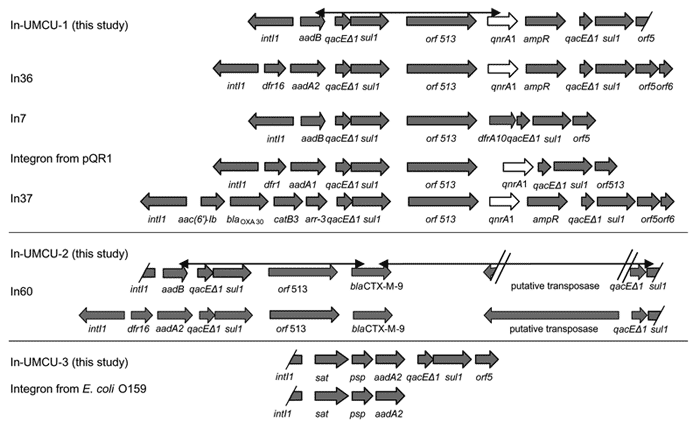Volume 12, Number 5—May 2006
Dispatch
Enterobacter cloacae Outbreak and Emergence of Quinolone Resistance Gene in Dutch Hospital
Figure 1

Figure 1. Schematic presentation of integrons on pQC compared with previously described integrons (5,9,19,21,22). The black double-pointed arrows indicate the product amplified with an Expand Long Template PCR system (Roche, Woerden, the Netherlands), demonstrating a link between the qnrA and blaCTX-M-9 genes and their respective integrons.
References
- Martínez-Martínez L, Pascual A, Jacoby GA. Quinolone resistance from a transferable plasmid. Lancet. 1998;351:797–9. DOIPubMedGoogle Scholar
- Nordmann P, Poirel L. Emergence of plasmid-mediated resistance to quinolones in Enterobacteriaceae. J Antimicrob Chemother. 2005;56:463–9. DOIPubMedGoogle Scholar
- Jacoby GA, Chow N, Waites KB. Prevalence of plasmid-mediated quinolone resistance. Antimicrob Agents Chemother. 2003;47:559–62. DOIPubMedGoogle Scholar
- Rodríguez-Martínez JM, Pascual A, García I, Martínez-Martínez L. Detection of the plasmid-mediated quinolone resistance determinant qnr among clinical isolates of Klebsiella pneumoniae producing AmpC-type beta-lactamase. J Antimicrob Chemother. 2003;52:703–6. DOIPubMedGoogle Scholar
- Wang M, Tran JH, Jacoby GA, Zhang Y, Wang F, Hooper DC. Plasmid-mediated quinolone resistance in clinical isolates of Escherichia coli from Shanghai, China. Antimicrob Agents Chemother. 2003;47:2242–8. DOIPubMedGoogle Scholar
- Wang M, Sahm DF, Jacoby GA, Hooper DC. Emerging plasmid-mediated quinolone resistance associated with the qnr gene in Klebsiella pneumoniae clinical isolates in the United States. Antimicrob Agents Chemother. 2004;48:1295–9. DOIPubMedGoogle Scholar
- Poirel L, Van De LM, Mammeri H, Nordmann P. Association of plasmid-mediated quinolone resistance with extended-spectrum β-lactamase VEB-1. Antimicrob Agents Chemother. 2005;49:3091–4. DOIPubMedGoogle Scholar
- Jonas D, Biehler K, Hartung D, Spitzmüller B, Daschner FD. Plasmid-mediated quinolone resistance in isolates obtained in German intensive care units. Antimicrob Agents Chemother. 2005;49:773–5. DOIPubMedGoogle Scholar
- Mammeri H, Van De LM, Poirel L, Martínez-Martínez L, Nordmann P. Emergence of plasmid-mediated quinolone resistance in Escherichia coli in Europe. Antimicrob Agents Chemother. 2005;49:71–6. DOIPubMedGoogle Scholar
- Leverstein-van Hall MA, Blok HE, Paauw A, Fluit AC, Troelstra A, Mascini EM, Extensive hospital-wide spread of a multidrug-resistant Enterobacter cloacae clone, with late detection due to a variable antibiogram and frequent patient transfer. J Clin Microbiol. 2006;44:518–24. DOIPubMedGoogle Scholar
- Leverstein-van Hall MA, Blok HEM, Donders ART, Paauw A, Fluit AC, Verhoef J. Multidrug resistance among Enterobacteriaceae is strongly associated with the presence of integrons and is independent of species or isolate origin. J Infect Dis. 2003;187:251–9. DOIPubMedGoogle Scholar
- Clinical and Laboratory Standards Institute. (formerly NCCLS). Performance standards for antimicrobial susceptibility testing: fourteenth international supplement. NCCLS Document M100-S14. Wayne (PA): The Institute; 2004.
- Leverstein-van Hall MA, Fluit AC, Blok HE, Box AT, Peters ED, Weersink AJ, Control of nosocomial multiresistant Enterobacteriaceae using a temporary restrictive antibiotic agent policy. Eur J Clin Microbiol Infect Dis. 2001;20:785–91. DOIPubMedGoogle Scholar
- Cantón R, Oliver A, Coque TM, Varela MD, Pérez-Díaz JC, Baquero F. Epidemiology of extended-spectrum beta-lactamase-producing Enterobacter isolates in a Spanish hospital during a 12-year period. J Clin Microbiol. 2002;40:1237–43. DOIPubMedGoogle Scholar
- Lévesque C, Piché L, Larose C, Roy PH. PCR mapping of integrons reveals several novel combinations of resistance genes. Antimicrob Agents Chemother. 1995;39:185–91.PubMedGoogle Scholar
- Steward CD, Rasheed JK, Hubert SK, Biddle JW, Raney PM, Anderson GJ, Characterization of clinical isolates of Klebsiella pneumoniae from 19 laboratories using the National Committee for Clinical Laboratory Stands extended-spectrum beta-lactamase detection methods. J Clin Microbiol. 2001;39:2864–72. DOIPubMedGoogle Scholar
- Nijssen S, Florijn A, Top J, Willems R, Fluit A, Bonten M. Unnoticed outbreaks of integron-carrying Enterobacteriaceae in an ICU. Clin Infect Dis. 2005;41:1–9. DOIPubMedGoogle Scholar
- Pérez-Pérez FJ, Hanson ND. Detection of plasmid-mediated AmpC β-lactamase genes in clinical isolates by using multiplex PCR. J Clin Microbiol. 2002;40:2153–62. DOIPubMedGoogle Scholar
- Parsons Y, Hall RM, Stokes HW. A new trimethoprim resistance gene, dhfrX, in the In7 integron of plasmid pDGO100. Antimicrob Agents Chemother. 1991;35:2436–9.PubMedGoogle Scholar
- Stokes HW, Tomaras C, Parsons Y, Hall RM. The partial 3´-conserved segment duplications in the integrons In6 from pSa and In7 from pDGO100 have a common origin. Plasmid. 1993;30:39–50. DOIPubMedGoogle Scholar
- Sabaté M, Navarro F, Miró E, Campoy S, Mirelis B, Barbé J, Novel complex sul1-type integron in Escherichia coli carrying blaCTX-M-9. Antimicrob Agents Chemother. 2002;46:2656–61. DOIPubMedGoogle Scholar
- Ahmed AM, Shimamoto T. A plasmid-encoded class 1 integron carrying sat, a putative phosphoserine phosphatase gene and aadA2 from enterotoxigenic Escherichia coli O159 isolated in Japan. FEMS Microbiol Lett. 2004;235:243–8. DOIPubMedGoogle Scholar
- Leverstein-van Hall MA, Box AT, Blok HE, Paauw A, Fluit AC, Evidence of extensive interspecies transfer of integron-mediated antimicrobial resistance genes among multidrug-resistant Enterobacteriaceae in a clinical setting. J Infect Dis. 2002;186:49–56. DOIPubMedGoogle Scholar
- Verdet C, Arlet G, Barnaud G, Lagrange PH, Philippon A. A novel integron in Salmonella enterica serovar Enteritidis, carrying the bla(DHA-1) gene and its regulator gene ampR, originated from Morganella morganii. Antimicrob Agents Chemother. 2000;44:222–5. DOIPubMedGoogle Scholar
- Robicsek A, Sahm DF, Strahilevitz J, Jacoby GA, Hooper DC. Broader distribution of plasmid-mediated quinolone resistance in the United States. Antimicrob Agents Chemother. 2005;49:3001–3. DOIPubMedGoogle Scholar
- Jeong JY, Yoon HJ, Kim ES, Lee Y, Choi SH, Kim NJ, Detection of qnr in clinical isolates of Escherichia coli from Korea. Antimicrob Agents Chemother. 2005;49:2522–4. DOIPubMedGoogle Scholar
- Nazic H, Poirel L, Nordmann P. Further identification of plasmid-mediated quinolone resistance determinant in Enterobacteriaceae in Turkey. Antimicrob Agents Chemother. 2005;49:2146–7. DOIPubMedGoogle Scholar
- Tran JH, Jacoby GA. Mechanism of plasmid-mediated quinolone resistance. Proc Natl Acad Sci U S A. 2002;99:5638–42. DOIPubMedGoogle Scholar
- Martínez-Martínez L, Pascual A, García I, Tran J, Jacoby GA. Interaction of plasmid and host quinolone resistance. J Antimicrob Chemother. 2003;51:1037–9. DOIPubMedGoogle Scholar
Page created: January 12, 2012
Page updated: January 12, 2012
Page reviewed: January 12, 2012
The conclusions, findings, and opinions expressed by authors contributing to this journal do not necessarily reflect the official position of the U.S. Department of Health and Human Services, the Public Health Service, the Centers for Disease Control and Prevention, or the authors' affiliated institutions. Use of trade names is for identification only and does not imply endorsement by any of the groups named above.